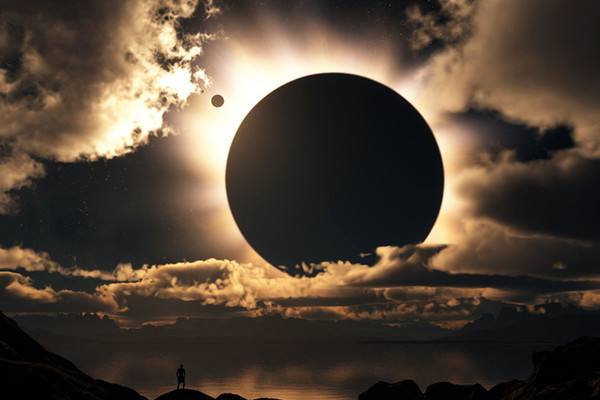(单词翻译:单击)
听力文本
This is Scientific American — 60-Second Science. I'm Emily Schwing.
More than 900 years ago, the Pueblo people were thriving in New Mexico's Chaco Canyon. While they were there, the region experienced what the whole country is looking forward to on August 21st: a total solar eclipse. Theirs took place in the year 1097—and they may have left a record of the event.
"I spotted this very peculiar petroglyph, which was a round object."
Kim Malville is a retired Solar Astronomer from the University of Colorado Boulder. In 1992, he and colleagues were leading a field course in Chaco Canyon when he noticed a unique carving on the south side of a rock.
"...which was a round object with loops coming out of it, and it struck me as maybe this was an image of the sun with the corona in a very active state. And maybe at that time, there is what is known as a coronal mass ejection."
That's when a giant cloud of plasma spirals off the sun's surface because of a solar flare. "It was somewhat foolhardy I suppose, on our part to suggest a particular explanation for it." But Malville knew that he had a testable hypothesis.

Astronomers knew that the region had a total solar eclipse on July 11, 1097. During the brief darkness, the sun's corona would have been visible. Solar activity increases and decreases on a roughly 11-year cycle, so Malville used various historic records to find out what was happening in 1097.
"And all of these indicated that in 1097, the sun was indeed in a state of very high activity and thus, we couldn't prove that this was actually an image of the corona, but we could not falsify our hypothesis."
In another portion of Chaco Canyon, a pictograph high on an overhang has been interpreted as marking a supernova explosion in 1054. Below that, a pictograph may mark the sighting of Hailey's Comet in 1066.
"And all three of them may have played a role in intensifying people's interest in the heavens and looking at the heavens very carefully."
Which is exactly what millions of current residents will be doing during this summer's solar eclipse over North America.
Thanks for listening for Scientific American — 60-Second Science Science. I'm Emily Schwing.
参考译文
这里是科学美国人——60秒科学。我是埃米莉·施温。
900多年前,普韦布洛人在新墨西哥州查科峡谷过着繁荣昌盛的生活。那时,查科峡谷经历了如今整个美国都在翘首以盼的事情:将于8月21日发生的日全食。那次日全食发生在1097年,普韦布洛人可能留下了日全食的记录。
“我发现了这个非常奇特的岩石雕刻,上面是一个圆形物体。”
金·马勒维尔是科罗拉多大学博尔德分校一位已退休的太阳天文学家。1992年,和同事在查科峡谷地区进行实地考察时,他注意到一块石岩的南侧有一个独特的雕刻。
“……那是一个圆形物体,周围有圆环,那让我感到震惊,因为这可能是太阳日冕处于非常活跃状态时的图像。也许当时发生了日冕物质抛射。”
日冕物质抛射是在太阳耀斑的作用下,巨型等离子云盘旋逃脱太阳表面的现象。“我们对岩石雕刻进行了具体解释,我想那可能有些粗糙。”不过,马勒维尔知道他有可验证的假说。一个可测试的假设。
天文学家知道查科峡谷在1907年7月11日发生了日全食。在那短暂的黑暗期间,太阳日冕应该可见。太阳活动的增减周期约为11年,因此,马勒维尔利用各种历史记录来查证1097年到底发生了什么。
“所有记录都表明,1097年太阳的确处于非常活跃的状态,但我们无法就此证明岩石上所刻的就是日冕,我们不能篡改我们的假说。”
在查科峡谷另一处,悬崖高处的象形文字经翻译后被解读为记录1054年发生的超新星爆炸事件。其下方的象形文字则可能记录的是1066年哈雷彗星经过地球的景象。
“这三幅壁画可能在提高人们对天空的兴趣方面发挥了一定作用,让人们更仔细地观察天空。”
这正是今年夏天北美洲日全食期间,数百万名居民会做的事。
谢谢大家收听科学美国人——60秒科学。我是埃米莉·施温。
译文为可可英语翻译,未经授权请勿转载!
重点讲解
重点讲解:
1. look forward to sth./doing sth. 期待;盼望;
例句:We look forward to cooperating with you!
我们期待与您的愉快合作!
2. take place (尤指在控制或组织下)发生,进行,举行;
例句:This year's event will take place on June 19th, a week earlier than usual.
今年的活动将于6月19日举行,比往年提前一周。
3. be known as 称为;叫做;
例句:He was known as Mad Shelley partly because of his eccentricity and partly because of his violent temper.
大家都叫他“疯子谢利”,部分因为他的古怪,部分因为他火爆的脾气。
4. find out (尤指特意通过努力)发现,找出,查明;
例句:I want you to do everything you can to find out who's responsible.
我希望你能尽一切可能找出责任人。


